Publications
Here go my publications and preprints in reversed chronological order.
2025
-
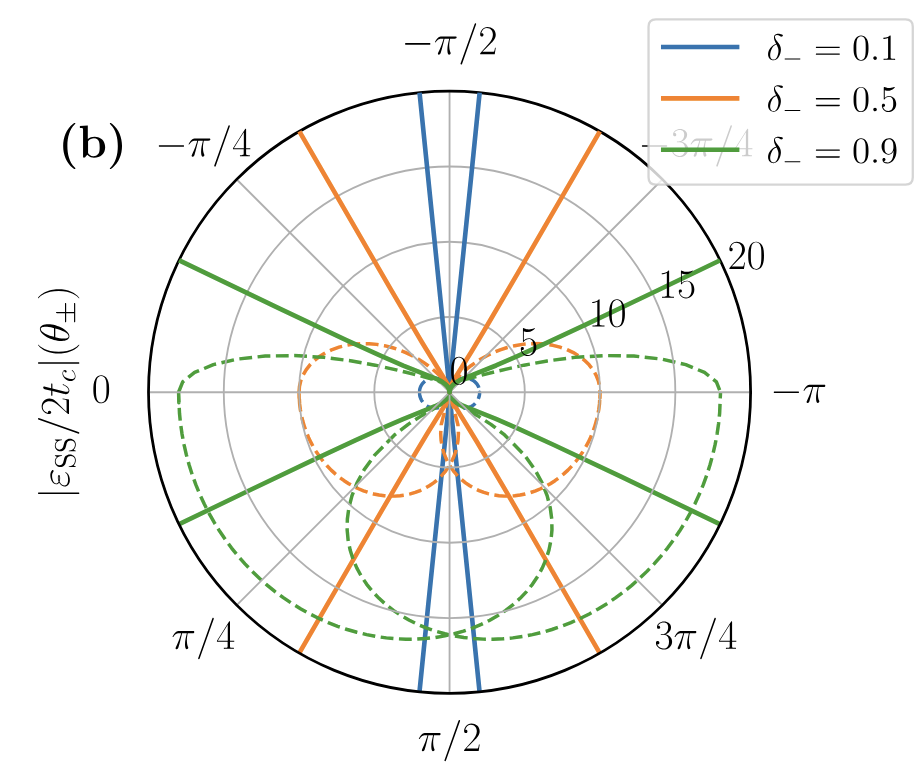 Sweet-spot protection of hole spins in sparse arrays via spin-dependent magneto-tunnelingEsteban A Rodrı́guez-Mena, Biel Martı́nez, Ahmad Fouad Kalo, Yann-Michel Niquet, and Jose Carlos Abadillo-Urielarxiv, 2025
Sweet-spot protection of hole spins in sparse arrays via spin-dependent magneto-tunnelingEsteban A Rodrı́guez-Mena, Biel Martı́nez, Ahmad Fouad Kalo, Yann-Michel Niquet, and Jose Carlos Abadillo-Urielarxiv, 2025Recent advances in the scaling of spin qubits have led to the development of sparse architectures where spin qubits are distributed across multiple quantum dots. This distributed approach enables qubit manipulation through hopping and flopping modes, as well as protocols for spin shuttling to entangle spins beyond nearest neighbors. Therefore, understanding spin tunneling across quantum dots is fundamental for the improvement of sparse array encodings. Here, we develop a microscopic theory of a minimal sparse array formed by a hole in a double quantum dot. We show the existence of spin-dependent magnetic corrections to the tunnel couplings that help preserve existing sweet spots, even for quantum dots with different -factors, and introduce new ones that are not accounted for in the simplest models. Our analytical and numerical results explain observed sweet spots in state-of-the-art shuttling and cQED experiments, are relevant to hopping and flopping modes, and apply broadly to sparse array encodings of any size.
@article{sagaseta2025switchable, title = {Sweet-spot protection of hole spins in sparse arrays via spin-dependent magneto-tunneling}, author = {Rodr{\'\i}guez-Mena, Esteban A and Mart{\'\i}nez, Biel and Kalo, Ahmad Fouad and Niquet, Yann-Michel and Abadillo-Uriel, Jose Carlos}, year = {2025}, doi = {arXiv:2510.25857v1}, } -
 Switchable spin-photon coupling with hole spins in single-quantum dotsCarlos Sagaseta, Marı́a José Calderón, and Jose Carlos Abadillo-Urielarxiv, 2025
Switchable spin-photon coupling with hole spins in single-quantum dotsCarlos Sagaseta, Marı́a José Calderón, and Jose Carlos Abadillo-Urielarxiv, 2025Spin qubits in semiconductor quantum dots offer a gate-tunable platform for quantum information processing. While two-qubit interactions are typically realized through exchange coupling between neighboring spins, coupling spin qubits to photons via hybrid spin-cQED devices enables long-range interactions and integration with other cQED platforms. Here, we investigate hole spin-photon coupling in compact single quantum dot setups. By incorporating ubiquitous strain inhomogeneities to our theory, we identify three main spin-photon coupling channels: a vector-potential-spin-orbit geometric mechanism–dominant for vertical magnetic fields–, an inhomogeneous Rashba term generalizing previous spin-orbit field models, and strain-induced -tensor terms–most relevant for in-plane fields. Comparing Si, unstrained (relaxed) Ge, and biaxially strained Ge wells, we find that Si and unstrained Ge provide optimal coupling strengths (tens of MHz) thanks to their reduced heavy-hole, light-hole splitting. We demonstrate efficient switching of the spin-photon coupling while preserving sweet spot operation. Finally, we evaluate quantum state transfer and two-qubit gate protocols, achieving >99% fidelity for state transfer and >90%for two-qubit gates with realistic coherence times, establishing single-dot hole spins as a viable platform for compact spin-cQED architectures and highlighting unstrained Ge as a promising candidate for spin-photon interactions.
@article{sagaseta2025switchablf, title = {Switchable spin-photon coupling with hole spins in single-quantum dots}, author = {Sagaseta, Carlos and Calder{\'o}n, Mar{\'\i}a Jos{\'e} and Abadillo-Uriel, Jose Carlos}, year = {2025}, doi = {arXiv:2510.05301v1}, } -
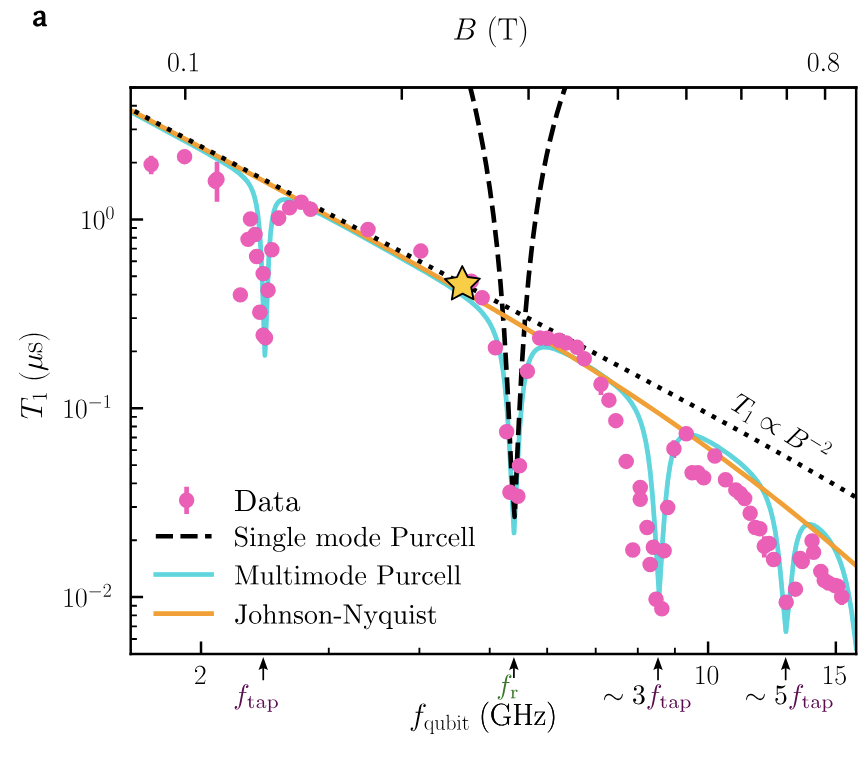 Coherence of a hole spin flopping-mode qubit in a circuit quantum electrodynamics environmentLéo Noirot, Cécile X Yu, Jose Carlos Abadillo-Uriel, Étienne Dumur, Heimanu Niebojewski, Benoit Bertrand, and 2 more authorsarxiv, 2025
Coherence of a hole spin flopping-mode qubit in a circuit quantum electrodynamics environmentLéo Noirot, Cécile X Yu, Jose Carlos Abadillo-Uriel, Étienne Dumur, Heimanu Niebojewski, Benoit Bertrand, and 2 more authorsarxiv, 2025The entanglement of microwave photons and spin qubits in silicon represents a pivotal step forward for quantum information processing utilizing semiconductor quantum dots. Such hybrid spin circuit quantum electrodynamics (cQED) has been achieved by granting a substantial electric dipole moment to a spin by de-localizing it in a double quantum dot under spin-orbit interaction, thereby forming a flopping-mode (FM) spin qubit. Despite its promise, the coherence properties demonstrated to date remain insufficient to envision FM spin qubits as practical single qubits. Here, we present a FM hole spin qubit in a silicon nanowire coupled to a high-impedance niobium nitride microwave resonator for readout. We report Rabi frequencies exceeding 100 MHz and coherence times in the microsecond range, resulting in a high single gate quality factor of 380. This establishes FM spin qubits as fast and reliable qubits. Moreover, using the large frequency tunability of the FM qubit, we reveal for the first time that photonic effects predominantly limit coherence, with radiative decay being the main relaxation channel and photon shot-noise inducing dephasing. These results highlight that optimized microwave engineering can unlock the potential of FM spin qubits in hybrid cQED architectures, offering a scalable and robust platform for fast and coherent spin qubits with strong coupling to microwave photons.
@article{noirot2025coherence, title = {Coherence of a hole spin flopping-mode qubit in a circuit quantum electrodynamics environment}, author = {Noirot, L{\'e}o and Yu, C{\'e}cile X and Abadillo-Uriel, Jose Carlos and Dumur, {\'E}tienne and Niebojewski, Heimanu and Bertrand, Benoit and Maurand, Romain and Zihlmann, Simon}, year = {2025}, doi = {arXiv:2503.10788v1}, } -
 Theory of superconducting proximity effect in hole-based hybrid semiconductor-superconductor devicesD Michel Pino, Rubén Seoane-Souto, Maria José Calderón, Ramón Aguado, and Jose Carlos Abadillo-UrielPhysical Review B, 2025
Theory of superconducting proximity effect in hole-based hybrid semiconductor-superconductor devicesD Michel Pino, Rubén Seoane-Souto, Maria José Calderón, Ramón Aguado, and Jose Carlos Abadillo-UrielPhysical Review B, 2025Hybrid superconductor-semiconductor systems have received a great deal of attention in the last few years because of their potential for quantum engineering, including novel qubits and topological devices. The proximity effect, the process by which the semiconductor inherits superconducting correlations, is an essential physical mechanism of such hybrids. Recent experiments have demonstrated the proximity effect in hole-based semiconductors, but, in contrast to electrons, the precise mechanism by which the hole bands acquire superconducting correlations remains an open question. In addition, hole spins exhibit a complex strong spin-orbit interaction, with largely anisotropic responses to electric and magnetic fields, further motivating the importance of understanding the interplay between such effects and the proximity effect. In this work, we analyze this physics with focus on germanium-based two-dimensional gases. Specifically, we develop an effective theory supported by full numerics, allowing us to extract various analytical expressions and predict different types of superconducting correlations including non-standard forms of singlet and triplet pairing mechanisms with non-trivial momentum dependence; as well as different Zeeman and Rashba spin-orbit contributions. This, together with their precise dependence on electric and magnetic fields, allows us to make specific experimental predictions, including the emergence of f-type superconductivity, Bogoliubov Fermi surfaces, and gapless regimes caused by large in-plane magnetic fields.
@article{pino2024theory, title = {Theory of superconducting proximity effect in hole-based hybrid semiconductor-superconductor devices}, author = {Pino, D Michel and Seoane-Souto, Rub{\'e}n and Calder{\'o}n, Maria Jos{\'e} and Aguado, Ram{\'o}n and Abadillo-Uriel, Jose Carlos}, journal = {Physical Review B}, volume = {111}, number = {23}, pages = {235443}, year = {2025}, publisher = {APS}, doi = {10.1103/mmsd-wfnf}, } -
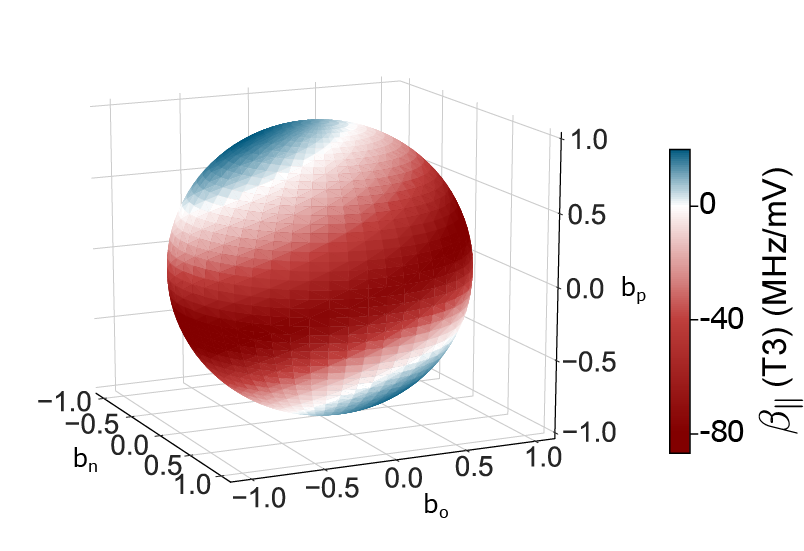 Optimal operation of hole spin qubitsMarion Bassi, Esteban-Alonso Rodrıguez-Mena, Boris Brun, Simon Zihlmann, Thanh Nguyen, Victor Champain, and 5 more authorsNature Physics, 2025
Optimal operation of hole spin qubitsMarion Bassi, Esteban-Alonso Rodrıguez-Mena, Boris Brun, Simon Zihlmann, Thanh Nguyen, Victor Champain, and 5 more authorsNature Physics, 2025Hole spins in silicon or germanium quantum dots have emerged as a compelling solid-state platform for scalable quantum processors. Besides relying on well-established manufacturing technologies, hole-spin qubits feature fast, electric-field-mediated control stemming from their intrinsically large spin-orbit coupling [1, 2]. This key feature is accompanied by an undesirable susceptibility to charge noise, which usually limits qubit coherence. Here, by varying the magnetic-field orientation, we experimentally establish the existence of “sweetlines” in the polar-azimuthal manifold where the qubit is insensitive to charge noise. In agreement with recent predictions [3], we find that the observed sweetlines host the points of maximal driving efficiency, where we achieve fast Rabi oscillations with quality factors as high as 1200. Furthermore, we demonstrate that moderate adjustments in gate voltages can significantly shift the sweetlines. This tunability allows multiple qubits to be simultaneously made insensitive to electrical noise, paving the way for scalable qubit architectures that fully leverage all-electrical spin control. The conclusions of this experimental study, performed on a silicon metal-oxide-semiconductor device, are expected to apply to other implementations of hole spin qubits.
@article{bassi2024optimal, title = {Optimal operation of hole spin qubits}, author = {Bassi, Marion and Rodr{\i}guez-Mena, Esteban-Alonso and Brun, Boris and Zihlmann, Simon and Nguyen, Thanh and Champain, Victor and Abadillo-Uriel, Jose Carlos and Bertrand, Benoit and Niebojewski, Heimanu and Maurand, Romain and others}, journal = {Nature Physics}, year = {2025}, url = {https://www.nature.com/articles/s41567-025-03106-1}, doi = {10.1038/s41567-025-03106-1}, } -
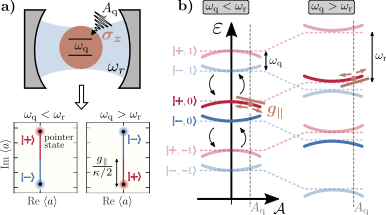 Unifying Floquet theory of longitudinal and dispersive readoutAlessandro Chessari, Esteban A Rodrı́guez-Mena, Jose Carlos Abadillo-Uriel, Victor Champain, Simon Zihlmann, Romain Maurand, and 2 more authorsPhysical Review Letters, 2025
Unifying Floquet theory of longitudinal and dispersive readoutAlessandro Chessari, Esteban A Rodrı́guez-Mena, Jose Carlos Abadillo-Uriel, Victor Champain, Simon Zihlmann, Romain Maurand, and 2 more authorsPhysical Review Letters, 2025We devise a Floquet theory of longitudinal and dispersive readout in circuit QED. By studying qubits coupled to cavity photons and driven at the resonance frequency of the cavity ωr, we establish a universal connection between the qubit AC Stark shift and the longitudinal and dispersive coupling to photons. We find that the longitudinal coupling g∥ is controlled by the slope of the AC Stark shift as function of the driving strength Aq, while the dispersive shift χ depends on its curvature. The two quantities become proportional to each other in the weak drive limit (Aq→0). Our approach unifies the adiabatic limit (ωr→0) – where g∥ is generated by the static spectrum curvature (or quantum capacitance) – with the diabatic one, where the static spectrum plays no role. We derive analytical results supported by exact numerical simulations. We apply them to superconducting and spin-hybrid cQED systems, showcasing the flexibility of faster-than-dispersive longitudinal readout.
@article{chessari2024unifying, title = {Unifying Floquet theory of longitudinal and dispersive readout}, author = {Chessari, Alessandro and Rodr{\'\i}guez-Mena, Esteban A and Abadillo-Uriel, Jose Carlos and Champain, Victor and Zihlmann, Simon and Maurand, Romain and Niquet, Yann-Michel and Filippone, Michele}, journal = {Physical Review Letters}, volume = {134}, number = {3}, pages = {037003}, year = {2025}, publisher = {APS}, doi = {10.1103/PhysRevLett.134.037003}, }
2024
-
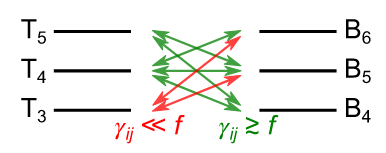 Non-symmetric Pauli spin blockade in a silicon double quantum dotTheodor Lundberg, David J Ibberson, Jing Li, Louis Hutin, Jose C Abadillo-Uriel, Michele Filippone, and 5 more authorsnpj Quantum Information, 2024
Non-symmetric Pauli spin blockade in a silicon double quantum dotTheodor Lundberg, David J Ibberson, Jing Li, Louis Hutin, Jose C Abadillo-Uriel, Michele Filippone, and 5 more authorsnpj Quantum Information, 2024Spin qubits in gate-defined silicon quantum dots are receiving increased attention thanks to their potential for large-scale quantum computing. Readout of such spin qubits is done most accurately and scalably via Pauli spin blockade (PSB), however various mechanisms may lift PSB and complicate readout. In this work, we present an experimental observation of a new, highly prevalent PSB-lifting mechanism in a silicon double quantum dot due to incoherent tunneling between different spin manifolds. Through dispersively-detected magnetospectroscopy of the double quantum dot in 16 charge configurations, we find the mechanism to be energy-level selective and non-reciprocal for neighbouring charge configurations. Additionally, using input-output theory we report a large coupling of different electron spin manifolds of 7.90 μeV, the largest reported to date, indicating an enhanced spin-orbit coupling which may enable all-electrical qubit control.
@article{lundberg2024non, title = {Non-symmetric Pauli spin blockade in a silicon double quantum dot}, author = {Lundberg, Theodor and Ibberson, David J and Li, Jing and Hutin, Louis and Abadillo-Uriel, Jose C and Filippone, Michele and Bertrand, Benoit and Nunnenkamp, Andreas and Lee, Chang-Min and Stelmashenko, Nadia and others}, journal = {npj Quantum Information}, volume = {10}, number = {1}, pages = {28}, year = {2024}, publisher = {Nature Publishing Group UK London}, url = {https://www.nature.com/articles/s41534-024-00820-1}, doi = {10.1038/s41534-024-00820-1}, }
2023
-
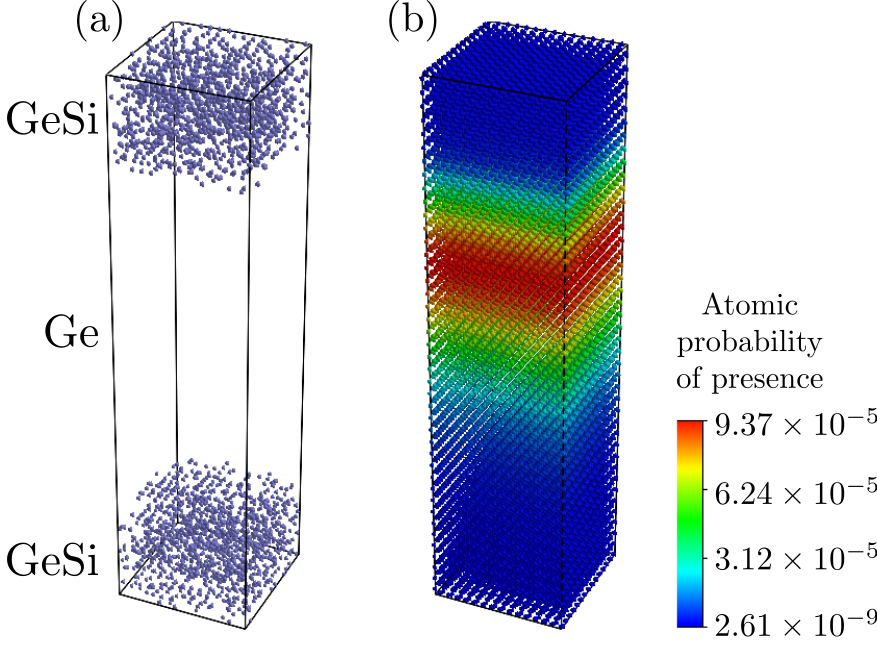 Linear-in-momentum spin orbit interactions in planar Ge/GeSi heterostructures and spin qubitsEsteban A Rodriguez-Mena, Jose Carlos Abadillo-Uriel, Gaëtan Veste, Biel Martinez, Jing Li, Benoı̂t Sklénard, and 1 more authorPhysical Review B, 2023
Linear-in-momentum spin orbit interactions in planar Ge/GeSi heterostructures and spin qubitsEsteban A Rodriguez-Mena, Jose Carlos Abadillo-Uriel, Gaëtan Veste, Biel Martinez, Jing Li, Benoı̂t Sklénard, and 1 more authorPhysical Review B, 2023We investigate the existence of linear-in-momentum spin-orbit interactions in the valence band of Ge/GeSi heterostructures using an atomistic tight-binding method. We show that symmetry breaking at the Ge/GeSi interfaces gives rise to a linear Dresselhaus-type interaction for heavy-holes. This interaction results from the heavy-hole/light-hole mixings induced by the interfaces and can be captured by a suitable correction to the minimal Luttinger-Kohn, four bands k⃗ ⋅p⃗ Hamiltonian. It is dependent on the steepness of the Ge/GeSi interfaces, and is suppressed if interdiffusion is strong enough. Besides the Dresselhaus interaction, the Ge/GeSi interfaces also make a contribution to the in-plane gyromagnetic g-factors of the holes. The tight-binding calculations also highlight the existence of a small linear Rashba interaction resulting from the couplings between the heavy-hole/light-hole manifold and the conduction band enabled by the low structural symmetry of Ge/GeSi heterostructures. These interactions can be leveraged to drive the hole spin. The linear Dresselhaus interaction may, in particular, dominate the physics of the devices for out-of-plane magnetic fields. When the magnetic field lies in-plane, it is, however, usually far less efficient than the g-tensor modulation mechanisms arising from the motion of the dot in non-separable, inhomogeneous electric fields and strains.
@article{rodriguez2023linear, title = {Linear-in-momentum spin orbit interactions in planar Ge/GeSi heterostructures and spin qubits}, author = {Rodriguez-Mena, Esteban A and Abadillo-Uriel, Jose Carlos and Veste, Ga{\"e}tan and Martinez, Biel and Li, Jing and Skl{\'e}nard, Beno{\^\i}t and Niquet, Yann-Michel}, journal = {Physical Review B}, volume = {108}, number = {20}, pages = {205416}, year = {2023}, publisher = {APS}, doi = {10.1103/PhysRevB.108.205416}, } -
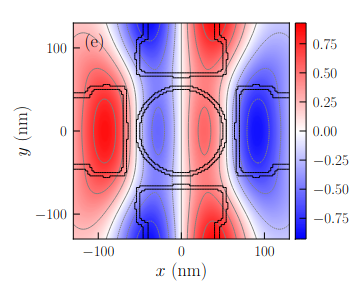 Hole spin driving by strain-induced spin-orbit interactionsJose Carlos Abadillo-Uriel, Esteban A Rodrı́guez-Mena, Biel Martinez, and Yann-Michel NiquetPhysical Review Letters, 2023
Hole spin driving by strain-induced spin-orbit interactionsJose Carlos Abadillo-Uriel, Esteban A Rodrı́guez-Mena, Biel Martinez, and Yann-Michel NiquetPhysical Review Letters, 2023Hole spins in semiconductor quantum dots can be efficiently manipulated with radio-frequency electric fields owing to the strong spin-orbit interactions in the valence bands. Here we show that the motion of the dot in inhomogeneous strain fields gives rise to linear Rashba spin-orbit interactions (with spatially dependent spin-orbit lengths) and g-factor modulations that allow for fast Rabi oscillations. Such inhomogeneous strains may build up spontaneously due to process and cool down stress. We discuss spin qubits in Ge/GeSi heterostructures as an illustration. We highlight that Rabi frequencies can be enhanced by one order of magnitude by shear strain gradients as small as 3x10^-6 nm^-1 within the dots. This underlines that spin in solids can be very sensitive to strains and opens the way for strain engineering in hole spin devices for quantum information and spintronics.
@article{abadillo2022hole, title = {Hole spin driving by strain-induced spin-orbit interactions}, author = {Abadillo-Uriel, Jose Carlos and Rodr{\'\i}guez-Mena, Esteban A and Martinez, Biel and Niquet, Yann-Michel}, journal = {Physical Review Letters}, volume = {131}, number = {9}, pages = {097002}, year = {2023}, publisher = {APS}, doi = {10.1103/PhysRevLett.131.097002}, } -
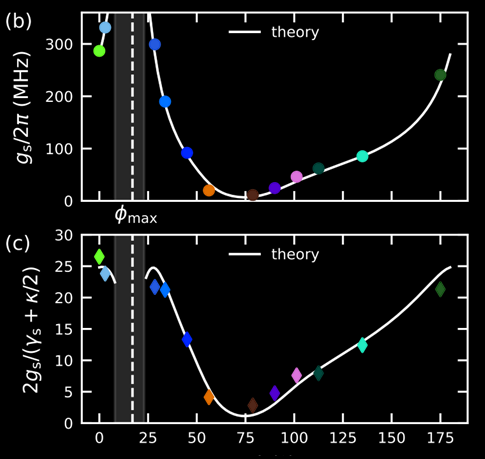 Strong coupling between a photon and a hole spin in siliconCécile X Yu, Simon Zihlmann, Jose C Abadillo-Uriel, Vincent P Michal, Nils Rambal, Heimanu Niebojewski, and 5 more authorsNature Nanotechnology, Mar 2023
Strong coupling between a photon and a hole spin in siliconCécile X Yu, Simon Zihlmann, Jose C Abadillo-Uriel, Vincent P Michal, Nils Rambal, Heimanu Niebojewski, and 5 more authorsNature Nanotechnology, Mar 2023Spins in semiconductor quantum dots constitute a promising platform for scalable quantum information processing. Coupling them strongly to the photonic modes of superconducting microwave resonators would enable fast non-demolition readout and long-range, on-chip connectivity, well beyond nearest-neighbor quantum interactions. Here we demonstrate strong coupling between a microwave photon in a superconducting resonator and a hole spin in a silicon-based double quantum dot issued from a foundry-compatible MOS fabrication process. By leveraging the strong spin-orbit interaction intrinsically present in the valence band of silicon, we achieve a spin-photon coupling rate as high as 330 MHz largely exceeding the combined spin-photon decoherence rate. This result, together with the recently demonstrated long coherence of hole spins in silicon, opens a new realistic pathway to the development of circuit quantum electrodynamics with spins in semiconductor quantum dots.
@article{yu2022strong, title = {Strong coupling between a photon and a hole spin in silicon}, author = {Yu, C{\'e}cile X and Zihlmann, Simon and Abadillo-Uriel, Jose C and Michal, Vincent P and Rambal, Nils and Niebojewski, Heimanu and Bedecarrats, Thomas and Vinet, Maud and Dumur, Etienne and Filippone, Michele and others}, journal = {Nature Nanotechnology}, pages = {1--6}, year = {2023}, month = mar, publisher = {Nature Publishing Group UK London}, url = {https://www.nature.com/articles/s41565-023-01332-3}, doi = {10.1038/s41565-023-01332-3}, } -
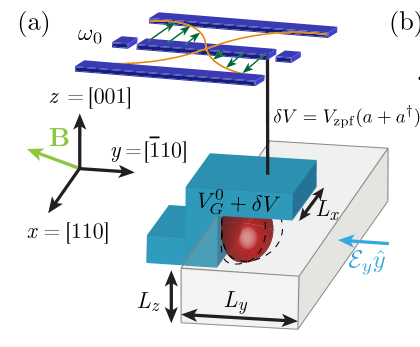 Tunable hole spin-photon interaction based on g-matrix modulationVP Michal, J C Abadillo-Uriel, S Zihlmann, R Maurand, Y-M Niquet, and M FilipponePhys. Rev. B, Jan 2023
Tunable hole spin-photon interaction based on g-matrix modulationVP Michal, J C Abadillo-Uriel, S Zihlmann, R Maurand, Y-M Niquet, and M FilipponePhys. Rev. B, Jan 2023We consider a spin circuit-QED device where a superconducting microwave resonator is capacitively coupled to a single hole confined in a semiconductor quantum dot. Thanks to the strong spin-orbit coupling intrinsic to valence-band states, the gyromagnetic g-matrix of the hole can be modulated electrically. This modulation couples the photons in the resonator to the hole spin. We show that the applied gate voltages and the magnetic-field orientation enable a versatile control of the spin-photon interaction, whose character can be switched from fully transverse to fully longitudinal. The longitudinal coupling is actually maximal when the transverse one vanishes and vice-versa. This "reciprocal sweetness" results from geometrical properties of the g-matrix and protects the spin against dephasing or relaxation. We estimate coupling rates reaching 10 MHz in realistic settings and discuss potential circuit-QED applications harnessing either the transverse or the longitudinal spin-photon interaction. Furthermore, we demonstrate that the g-matrix curvature can be used to achieve parametric longitudinal coupling with enhanced coherence.
@article{michal2022tunable, title = {Tunable hole spin-photon interaction based on g-matrix modulation}, author = {Michal, VP and Abadillo-Uriel, J C and Zihlmann, S and Maurand, R and Niquet, Y-M and Filippone, M}, journal = {Phys. Rev. B}, volume = {107}, issue = {4}, pages = {L041303}, numpages = {6}, year = {2023}, month = jan, publisher = {American Physical Society}, doi = {10.1103/PhysRevB.107.L041303}, url = {https://link.aps.org/doi/10.1103/PhysRevB.107.L041303}, }
2022
-
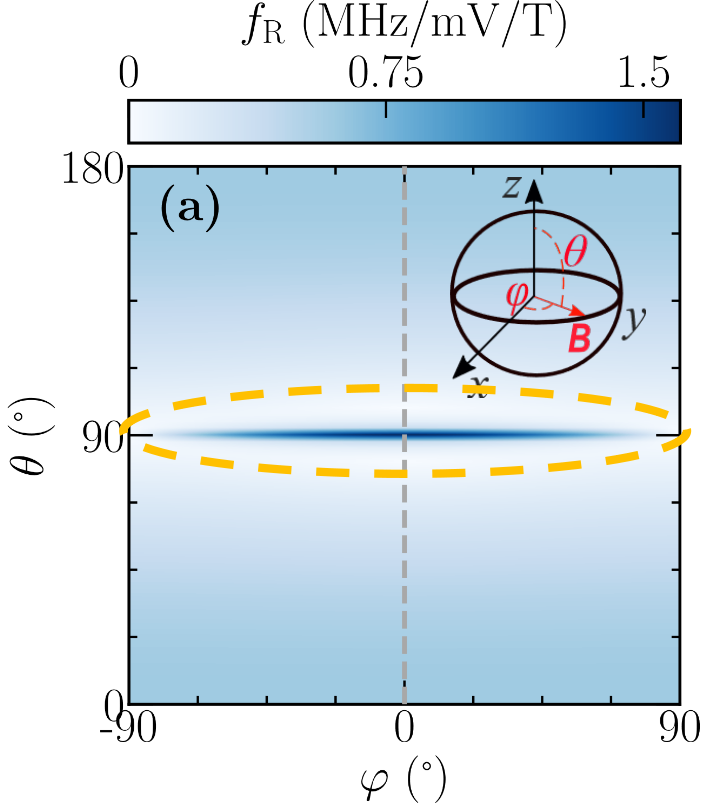 Hole spin manipulation in inhomogeneous and nonseparable electric fieldsBiel Martinez, Jose Carlos Abadillo-Uriel, Esteban A. Rodrı́guez-Mena, and Yann-Michel NiquetPhys. Rev. B, Dec 2022
Hole spin manipulation in inhomogeneous and nonseparable electric fieldsBiel Martinez, Jose Carlos Abadillo-Uriel, Esteban A. Rodrı́guez-Mena, and Yann-Michel NiquetPhys. Rev. B, Dec 2022The usual models for electrical spin manipulation in semiconductor quantum dots assume that the confinement potential is separable in the three spatial dimensions and that the ac drive field is homogeneous. However, the electric field induced by the gates in quantum dot devices is not fully separable and displays significant inhomogeneities. Here we address the electrical manipulation of hole spins in semiconductor heterostructures subject to inhomogeneous vertical electric fields and/or in-plane ac electric fields. We consider Ge quantum dots electrically confined in a Ge/GeSi quantum well as an illustration. We show that the lack of separability between the vertical and in-plane motions gives rise to an additional spin-orbit coupling mechanism (beyond the usual linear and cubic in momentum Rashba terms) that modulates the principal axes of the hole gyromagnetic g matrix. This nonseparability mechanism can be of the same order of magnitude as Rashba-type interactions, and enables spin manipulation when the magnetic field is applied in the plane of the heterostructure even if the dot is symmetric (disk shaped). More generally, we show that Rabi oscillations in strongly patterned electric fields harness a variety of g-factor modulations. We discuss the implications for the design, modeling, and understanding of hole spin qubit devices.
@article{PhysRevB.106.235426, title = {Hole spin manipulation in inhomogeneous and nonseparable electric fields}, author = {Martinez, Biel and Abadillo-Uriel, Jose Carlos and Rodr\'{\i}guez-Mena, Esteban A. and Niquet, Yann-Michel}, journal = {Phys. Rev. B}, volume = {106}, issue = {23}, pages = {235426}, numpages = {12}, year = {2022}, month = dec, publisher = {American Physical Society}, doi = {10.1103/PhysRevB.106.235426}, url = {https://link.aps.org/doi/10.1103/PhysRevB.106.235426}, } -
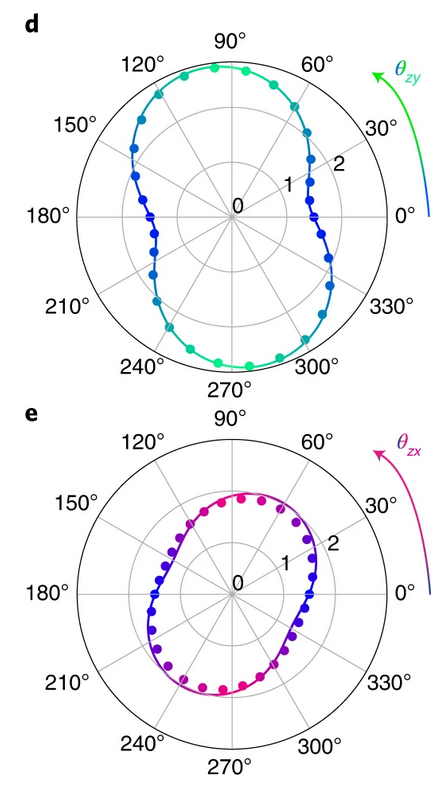 A single hole spin with enhanced coherence in natural siliconN. Piot, B. Brun, V. Schmitt, S. Zihlmann, V. P. Michal, A. Apra, and 11 more authorsNature Nanotechnology, Sep 2022
A single hole spin with enhanced coherence in natural siliconN. Piot, B. Brun, V. Schmitt, S. Zihlmann, V. P. Michal, A. Apra, and 11 more authorsNature Nanotechnology, Sep 2022Semiconductor spin qubits based on spin–orbit states are responsive to electric field excitations, allowing for practical, fast and potentially scalable qubit control. Spin electric susceptibility, however, renders these qubits generally vulnerable to electrical noise, which limits their coherence time. Here we report on a spin–orbit qubit consisting of a single hole electrostatically confined in a natural silicon metal-oxide-semiconductor device. By varying the magnetic field orientation, we reveal the existence of operation sweet spots where the impact of charge noise is minimized while preserving an efficient electric-dipole spin control. We correspondingly observe an extension of the Hahn-echo coherence time up to 88 μs, exceeding by an order of magnitude existing values reported for hole spin qubits, and approaching the state-of-the-art for electron spin qubits with synthetic spin–orbit coupling in isotopically purified silicon. Our finding enhances the prospects of silicon-based hole spin qubits for scalable quantum information processing.
@article{Piot2022, doi = {10.1038/s41565-022-01196-z}, url = {https://doi.org/10.1038/s41565-022-01196-z}, year = {2022}, month = sep, publisher = {Springer Science and Business Media {LLC}}, volume = {17}, number = {10}, pages = {1072--1077}, author = {Piot, N. and Brun, B. and Schmitt, V. and Zihlmann, S. and Michal, V. P. and Apra, A. and Abadillo-Uriel, J. C. and Jehl, X. and Bertrand, B. and Niebojewski, H. and Hutin, L. and Vinet, M. and Urdampilleta, M. and Meunier, T. and Niquet, Y.-M. and Maurand, R. and Franceschi, S. De}, title = {A single hole spin with enhanced coherence in natural silicon}, journal = {Nature Nanotechnology}, }
2021
-
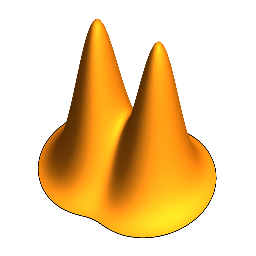 Two-body Wigner molecularization in asymmetric quantum dot spin qubitsJose C. Abadillo-Uriel, Biel Martinez, Michele Filippone, and Yann-Michel NiquetPhys. Rev. B, Nov 2021
Two-body Wigner molecularization in asymmetric quantum dot spin qubitsJose C. Abadillo-Uriel, Biel Martinez, Michele Filippone, and Yann-Michel NiquetPhys. Rev. B, Nov 2021Coulomb interactions strongly influence the spectrum and the wave functions of a few electrons or holes confined in a quantum dot. In particular, when the confinement potential is not too strong, the Coulomb repulsion triggers the formation of a correlated state, the Wigner molecule, where the particles tend to split apart. We show that the anisotropy of the confinement potential strongly enhances the molecularization process and affects the performances of quantum dot systems used as spin qubits. Relying on analytical and numerical solutions of the two-particle problem—both in a simplified single-band approximation and in realistic setups—we highlight the exponential suppression of the singlet-triplet gap with increasing anisotropy. We compare the molecularization effects in different semiconductor materials and discuss how they specifically hamper Pauli spin blockade readout and reduce the exchange interactions in two-qubit gates.
@article{PhysRevB.104.195305, title = {Two-body Wigner molecularization in asymmetric quantum dot spin qubits}, author = {Abadillo-Uriel, Jose C. and Martinez, Biel and Filippone, Michele and Niquet, Yann-Michel}, journal = {Phys. Rev. B}, volume = {104}, issue = {19}, pages = {195305}, numpages = {17}, year = {2021}, month = nov, publisher = {American Physical Society}, doi = {10.1103/PhysRevB.104.195305}, url = {https://link.aps.org/doi/10.1103/PhysRevB.104.195305}, } -
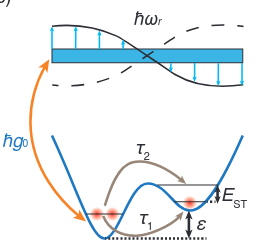 Long-range two-hybrid-qubit gates mediated by a microwave cavity with red sidebandsJ. C. Abadillo-Uriel, Cameron King, S. N. Coppersmith, and Mark FriesenPhys. Rev. A, Sep 2021
Long-range two-hybrid-qubit gates mediated by a microwave cavity with red sidebandsJ. C. Abadillo-Uriel, Cameron King, S. N. Coppersmith, and Mark FriesenPhys. Rev. A, Sep 2021Implementing two-qubit gates via strong coupling between quantum-dot qubits and a superconducting microwave cavity requires achieving coupling rates that are much faster than decoherence rates. Typically, this involves tuning the qubit either to a sweet spot, where it is relatively insensitive to charge noise, or to a point where it is resonant with the microwave cavity. Unfortunately, such operating points seldom coincide. Here we theoretically investigate protocols, based on transverse or longitudinal sideband driving, for implementing two-qubit gates between quantum-dot hybrid qubits, mediated by a microwave cavity. The rich physics in these qubits gives rise to two types of sweet spots, which can occur at operating points with strong charge dipole moments. Such strong interactions provide new opportunities for off-resonant gating, thereby removing one of the main obstacles for long-distance two-qubit gates. We find that the transverse driving scheme yields faster gates, while longitudinal driving yields gates that are more resilient to photon decay. Our results suggest that the numerous tuning knobs of quantum-dot hybrid qubits make them good candidates for strong coupling. In particular, we show that off-resonant red-sideband-mediated two-qubit gates can exhibit fidelities greater than 95% for realistic operating parameters, and we describe improvements that could potentially yield gate fidelities greater than 99%.
@article{PhysRevA.104.032612, title = {Long-range two-hybrid-qubit gates mediated by a microwave cavity with red sidebands}, author = {Abadillo-Uriel, J. C. and King, Cameron and Coppersmith, S. N. and Friesen, Mark}, journal = {Phys. Rev. A}, volume = {104}, issue = {3}, pages = {032612}, numpages = {14}, year = {2021}, month = sep, publisher = {American Physical Society}, doi = {10.1103/PhysRevA.104.032612}, url = {https://link.aps.org/doi/10.1103/PhysRevA.104.032612}, } -
 Coherent Control and Spectroscopy of a Semiconductor Quantum Dot Wigner MoleculeJ. Corrigan, J. P. Dodson, H. Ekmel Ercan, J. C. Abadillo-Uriel, Brandur Thorgrimsson, T. J. Knapp, and 9 more authorsPhys. Rev. Lett., Sep 2021
Coherent Control and Spectroscopy of a Semiconductor Quantum Dot Wigner MoleculeJ. Corrigan, J. P. Dodson, H. Ekmel Ercan, J. C. Abadillo-Uriel, Brandur Thorgrimsson, T. J. Knapp, and 9 more authorsPhys. Rev. Lett., Sep 2021Semiconductor quantum dots containing more than one electron have found wide application in qubits, where they enable readout and enhance polarizability. However, coherent control in such dots has typically been restricted to only the lowest two levels, and such control in the strongly interacting regime has not been realized. Here we report quantum control of eight different transitions in a silicon-based quantum dot. We use qubit readout to perform spectroscopy, revealing a dense set of energy levels with characteristic spacing far smaller than the single-particle energy. By comparing with full configuration interaction calculations, we argue that the dense set of levels arises from Wigner-molecule physics.
@article{PhysRevLett.127.127701, title = {Coherent Control and Spectroscopy of a Semiconductor Quantum Dot Wigner Molecule}, author = {Corrigan, J. and Dodson, J. P. and Ercan, H. Ekmel and Abadillo-Uriel, J. C. and Thorgrimsson, Brandur and Knapp, T. J. and Holman, Nathan and McJunkin, Thomas and Neyens, Samuel F. and MacQuarrie, E. R. and Foote, Ryan H. and Edge, L. F. and Friesen, Mark and Coppersmith, S. N. and Eriksson, M. A.}, journal = {Phys. Rev. Lett.}, volume = {127}, issue = {12}, pages = {127701}, numpages = {6}, year = {2021}, month = sep, publisher = {American Physical Society}, doi = {10.1103/PhysRevLett.127.127701}, url = {https://link.aps.org/doi/10.1103/PhysRevLett.127.127701}, } -
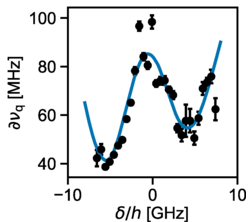 Charge qubit in a triple quantum dot with tunable coherenceB. Kratochwil, J. V. Koski, A. J. Landig, P. Scarlino, J. C. Abadillo-Uriel, C. Reichl, and 6 more authorsPhys. Rev. Res., Feb 2021
Charge qubit in a triple quantum dot with tunable coherenceB. Kratochwil, J. V. Koski, A. J. Landig, P. Scarlino, J. C. Abadillo-Uriel, C. Reichl, and 6 more authorsPhys. Rev. Res., Feb 2021The energy landscape of a single electron in a triple quantum dot can be tuned such that the energy separation between ground and excited states becomes a flat function of the relevant gate voltages. These so-called sweet spots are beneficial for charge coherence since the decoherence effects caused by small fluctuations of gate voltages or surrounding charge fluctuators are minimized. We propose a new operation point for a triple quantum dot charge qubit, a so-called CQ3-qubit, having a third-order sweet spot. We show strong coupling of the qubit to single photons in a frequency tunable high-impedance SQUID-array resonator. In the dispersive regime, we investigate the qubit linewidth in the vicinity of the proposed operating point. In contrast to the expectation for a higher-order sweet spot, we there find a local maximum of the linewidth. We find that this is due to a non-negligible contribution of noise on the quadrupolar detuning axis not being in a sweet spot at the proposed operating point. While the original motivation to realize a low-decoherence charge qubit was not fulfilled, our analysis provides insights into charge decoherence mechanisms relevant also for other qubits.
@article{PhysRevResearch.3.013171, title = {Charge qubit in a triple quantum dot with tunable coherence}, author = {Kratochwil, B. and Koski, J. V. and Landig, A. J. and Scarlino, P. and Abadillo-Uriel, J. C. and Reichl, C. and Coppersmith, S. N. and Wegscheider, W. and Friesen, Mark and Wallraff, A. and Ihn, T. and Ensslin, K.}, journal = {Phys. Rev. Res.}, volume = {3}, issue = {1}, pages = {013171}, numpages = {13}, year = {2021}, month = feb, publisher = {American Physical Society}, doi = {10.1103/PhysRevResearch.3.013171}, url = {https://link.aps.org/doi/10.1103/PhysRevResearch.3.013171}, }
2020
-
 Strong photon coupling to the quadrupole moment of an electron in a solid-state qubitJonne V Koski, Andreas J Landig, Maximilian Russ, Jose C Abadillo-Uriel, Pasquale Scarlino, Benedikt Kratochwil, and 5 more authorsNature Physics, Feb 2020
Strong photon coupling to the quadrupole moment of an electron in a solid-state qubitJonne V Koski, Andreas J Landig, Maximilian Russ, Jose C Abadillo-Uriel, Pasquale Scarlino, Benedikt Kratochwil, and 5 more authorsNature Physics, Feb 2020The fundamental concept of light–matter interaction is routinely realized by coupling the quantized electric field in a cavity to the dipole moment of a real or an artificial atom. A proposal recent, motivated by the prospect of overcoming the decohering effects of distant charge fluctuations, suggests that introduction of and coupling to an electric quadrupole moment of a single electron can be achieved by confining it in a triple quantum dot. Here, we show an experimental realization of this concept by connecting a superconducting microwave resonator to the middle of the three dots, such that the dipole coupling becomes negligible. We demonstrate strong coupling to the electron quadrupole moment and determine that the coherence of our system is limited by short-range charge noise. Our experiment enables the construction and detection of a complex electronic state of a single electron in a solid-state environment that does not exist as such for a free electron.
@article{koski2020strong, title = {Strong photon coupling to the quadrupole moment of an electron in a solid-state qubit}, author = {Koski, Jonne V and Landig, Andreas J and Russ, Maximilian and Abadillo-Uriel, Jose C and Scarlino, Pasquale and Kratochwil, Benedikt and Reichl, Christian and Wegscheider, Werner and Burkard, Guido and Friesen, Mark and others}, journal = {Nature Physics}, volume = {16}, number = {6}, pages = {642--646}, year = {2020}, publisher = {Nature Publishing Group}, url = {https://www.nature.com/articles/s41567-020-0862-4}, }
2019
-
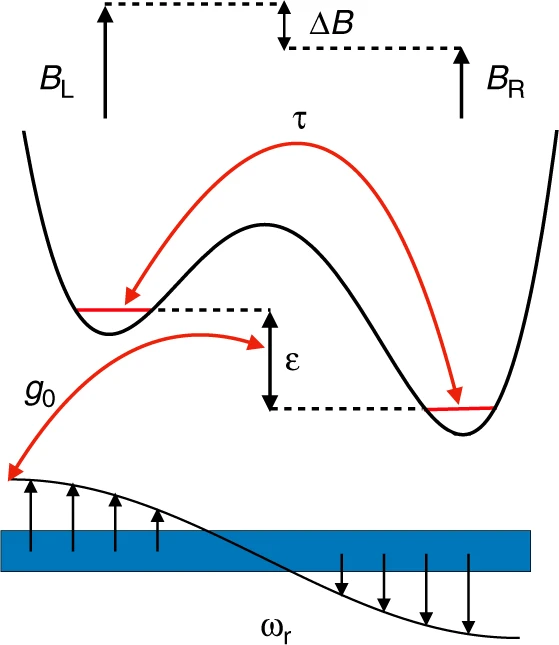 Enhancing the dipolar coupling of a S-T0 qubit with a transverse sweet spotJ C Abadillo-Uriel, MA Eriksson, SN Coppersmith, and Mark FriesenNature communications, Feb 2019
Enhancing the dipolar coupling of a S-T0 qubit with a transverse sweet spotJ C Abadillo-Uriel, MA Eriksson, SN Coppersmith, and Mark FriesenNature communications, Feb 2019A fundamental challenge for quantum dot spin qubits is to extend the strength and range of qubit interactions while suppressing their coupling to the environment, since both effects have electrical origins. Key tools include the ability to take advantage of physical resources in different regimes, and to access optimal working points, sweet spots, where dephasing is minimized. Here, we explore an important resource for singlet-triplet qubits: a transverse sweet spot (TSS) that enables transitions between qubit states, a strong dipolar coupling, and leading-order protection from electrical fluctuations. Of particular interest is the possibility of transitioning between the TSS and symmetric operating points while remaining continuously protected. This arrangement is ideal for coupling qubits to a microwave cavity, because it combines tunability of the coupling with noise insensitivity. We perform simulations with 1/f-type electrical noise, demonstrating that two-qubit gates mediated by a resonator can achieve fidelities >99% under realistic conditions.
@article{abadillo2019enhancing, title = {Enhancing the dipolar coupling of a S-T0 qubit with a transverse sweet spot}, author = {Abadillo-Uriel, J C and Eriksson, MA and Coppersmith, SN and Friesen, Mark}, journal = {Nature communications}, volume = {10}, number = {1}, pages = {1--8}, year = {2019}, publisher = {Nature Publishing Group}, url = {https://www.nature.com/articles/s41467-019-13548-w}, } -
 Virtual-photon-mediated spin-qubit–transmon couplingAndreas J Landig, Jonne V Koski, Pasquale Scarlino, Clemens Müller, Jose C Abadillo-Uriel, Benedikt Kratochwil, and 5 more authorsNature communications, Feb 2019
Virtual-photon-mediated spin-qubit–transmon couplingAndreas J Landig, Jonne V Koski, Pasquale Scarlino, Clemens Müller, Jose C Abadillo-Uriel, Benedikt Kratochwil, and 5 more authorsNature communications, Feb 2019Spin qubits and superconducting qubits are among the promising candidates for realizing a solid state quantum computer. For the implementation of a hybrid architecture which can profit from the advantages of either approach, a coherent link is necessary that integrates and controllably couples both qubit types on the same chip over a distance that is several orders of magnitude longer than the physical size of the spin qubit. We realize such a link with a frequency-tunable high impedance SQUID array resonator. The spin qubit is a resonant exchange qubit hosted in a GaAs triple quantum dot. It can be operated at zero magnetic field, allowing it to coexist with superconducting qubits on the same chip. We spectroscopically observe coherent interaction between the resonant exchange qubit and a transmon qubit in both resonant and dispersive regimes, where the interaction is mediated either by real or virtual resonator photons.
@article{landig2019virtual, title = {Virtual-photon-mediated spin-qubit--transmon coupling}, author = {Landig, Andreas J and Koski, Jonne V and Scarlino, Pasquale and M{\"u}ller, Clemens and Abadillo-Uriel, Jose C and Kratochwil, Benedikt and Reichl, Christian and Wegscheider, Werner and Coppersmith, Susan N and Friesen, Mark and others}, journal = {Nature communications}, volume = {10}, number = {1}, pages = {1--7}, year = {2019}, publisher = {Nature Publishing Group}, url = {https://www.nature.com/articles/s41467-019-13000-z}, }
2018
-
 Signatures of atomic-scale structure in the energy dispersion and coherence of a Si quantum-dot qubitJ. C. Abadillo-Uriel, Brandur Thorgrimsson, Dohun Kim, L. W. Smith, C. B. Simmons, Daniel R. Ward, and 8 more authorsPhys. Rev. B, Oct 2018
Signatures of atomic-scale structure in the energy dispersion and coherence of a Si quantum-dot qubitJ. C. Abadillo-Uriel, Brandur Thorgrimsson, Dohun Kim, L. W. Smith, C. B. Simmons, Daniel R. Ward, and 8 more authorsPhys. Rev. B, Oct 2018We report anomalous behavior in the energy dispersion of a three-electron double-quantum-dot hybrid qubit and argue that it is caused by atomic-scale disorder at the quantum-well interface. By employing tight-binding simulations, we identify potential disorder profiles that induce behavior consistent with the experiments. The results indicate that disorder can give rise to “sweet spots” where the decoherence caused by charge noise is suppressed, even in a parameter regime where true sweet spots are unexpected. Conversely, “hot spots” where the decoherence is enhanced can also occur. Our results suggest that interfacial atomic structure can be used in particular cases as a tool to enhance the fidelity of Si double-dot qubits.
@article{PhysRevB.98.165438, title = {Signatures of atomic-scale structure in the energy dispersion and coherence of a Si quantum-dot qubit}, author = {Abadillo-Uriel, J. C. and Thorgrimsson, Brandur and Kim, Dohun and Smith, L. W. and Simmons, C. B. and Ward, Daniel R. and Foote, Ryan H. and Corrigan, J. and Savage, D. E. and Lagally, M. G. and Calder\'on, M. J. and Coppersmith, S. N. and Eriksson, M. A. and Friesen, Mark}, journal = {Phys. Rev. B}, volume = {98}, issue = {16}, pages = {165438}, numpages = {7}, year = {2018}, month = oct, publisher = {American Physical Society}, doi = {10.1103/PhysRevB.98.165438}, url = {https://link.aps.org/doi/10.1103/PhysRevB.98.165438}, } -
 Two-dimensional semiconductors pave the way towards dopant-based quantum computingJose Carlos Abadillo-Uriel, Belita Koiller, and Marı́a José CalderónBeilstein journal of nanotechnology, Oct 2018
Two-dimensional semiconductors pave the way towards dopant-based quantum computingJose Carlos Abadillo-Uriel, Belita Koiller, and Marı́a José CalderónBeilstein journal of nanotechnology, Oct 2018Since the proposal in 1998 to build a quantum computer using dopants in silicon as qubits, much progress has been made in the nanofabrication of semiconductors and the control of charge and spins in single dopants. However, an important problem remains unsolved, namely the control over exchange interactions and tunneling between two donors, which presents a peculiar oscillatory behavior as the dopants relative positions vary at the scale of the lattice parameter. Such behavior is due to the valley degeneracy in the conduction band of silicon, and does not occur when the conduction-band edge is at k = 0. We investigate the possibility of circumventing this problem by using two-dimensional (2D) materials as hosts. Dopants in 2D systems are more tightly bound and potentially easier to position and manipulate. Moreover, many of them present the conduction band minimum at k = 0, thus no exchange or tunnel coupling oscillations. Considering the properties of currently available 2D semiconductor materials, we access the feasibility of such a proposal in terms of quantum manipulability of isolated dopants (for single qubit operations) and dopant pairs (for two-qubit operations). Our results indicate that a wide variety of 2D materials may perform at least as well as, and possibly better, than the currently studied bulk host materials for donor qubits.
@article{abadillo2018two, title = {Two-dimensional semiconductors pave the way towards dopant-based quantum computing}, author = {Abadillo-Uriel, Jose Carlos and Koiller, Belita and Calder{\'o}n, Mar{\'\i}a Jos{\'e}}, journal = {Beilstein journal of nanotechnology}, volume = {9}, number = {1}, pages = {2668--2673}, year = {2018}, publisher = {Beilstein-Institut}, url = {https://www.beilstein-journals.org/bjnano/articles/9/249} } -
 Electric-field tuning of the valley splitting in silicon corner dotsDavid J Ibberson, Léo Bourdet, Jose C Abadillo-Uriel, Imtiaz Ahmed, Sylvain Barraud, Marı́a J Calderón, and 2 more authorsApplied Physics Letters, Oct 2018
Electric-field tuning of the valley splitting in silicon corner dotsDavid J Ibberson, Léo Bourdet, Jose C Abadillo-Uriel, Imtiaz Ahmed, Sylvain Barraud, Marı́a J Calderón, and 2 more authorsApplied Physics Letters, Oct 2018We perform an excited state spectroscopy analysis of a silicon corner dot in a nanowire field-effect transistor to assess the electric field tunability of the valley splitting. First, we demonstrate a back-gate-controlled transition between a single quantum dot and a double quantum dot in parallel which allows tuning the device into corner dot formation. We find a linear dependence of the valley splitting on back-gate voltage, from 880 μeV to 610 μeV with a slope of −45 ± 3 μeV/V (or equivalently a slope of −48 ± 3 μeV/(MV/m) with respect to the effective field). The experimental results are backed up by tight-binding simulations that include the effect of surface roughness, remote charges in the gate stack, and discrete dopants in the channel. Our results demonstrate a way to electrically tune the valley splitting in silicon-on-insulator-based quantum dots, a requirement to achieve all-electrical manipulation of silicon spin qubits.
@article{ibberson2018electric, title = {Electric-field tuning of the valley splitting in silicon corner dots}, author = {Ibberson, David J and Bourdet, L{\'e}o and Abadillo-Uriel, Jose C and Ahmed, Imtiaz and Barraud, Sylvain and Calder{\'o}n, Mar{\'\i}a J and Niquet, Y-M and Gonzalez-Zalba, M Fernando}, journal = {Applied Physics Letters}, volume = {113}, number = {5}, pages = {053104}, year = {2018}, publisher = {AIP Publishing LLC}, url = {https://aip.scitation.org/doi/full/10.1063/1.5040474} } -
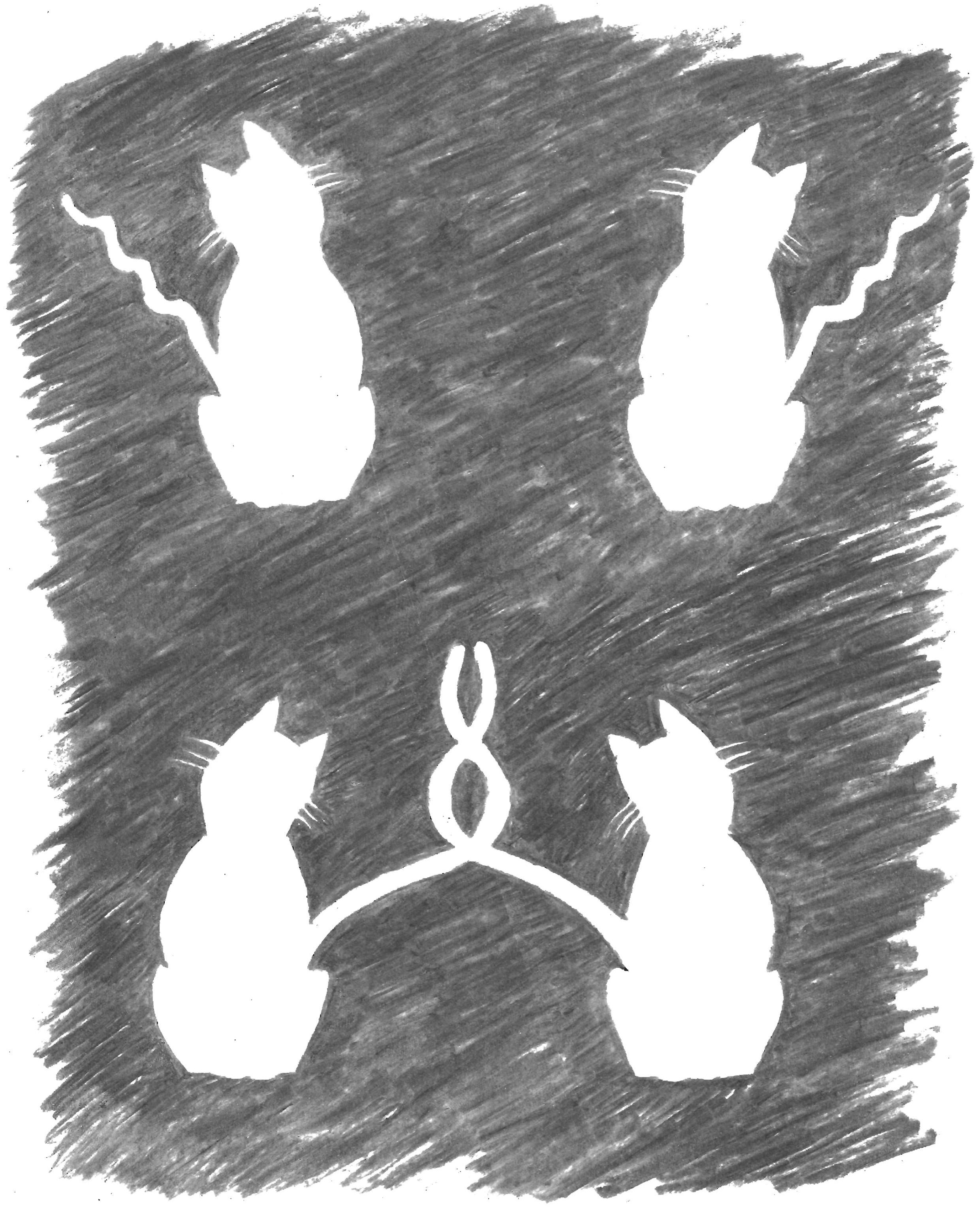 Entanglement control and magic angles for acceptor qubits in SiJose Carlos Abadillo-Uriel, Joe Salfi, Xuedong Hu, Sven Rogge, MJ Calderon, and Dimitrie CulcerApplied Physics Letters, Oct 2018
Entanglement control and magic angles for acceptor qubits in SiJose Carlos Abadillo-Uriel, Joe Salfi, Xuedong Hu, Sven Rogge, MJ Calderon, and Dimitrie CulcerApplied Physics Letters, Oct 2018Full electrical control of quantum bits could facilitate fast, low-power, scalable quantum computation. Although electric dipoles are highly attractive to couple spin qubits electrically over long distances, mechanisms identified to control two-qubit couplings do not permit single-qubit operations while two-qubit couplings are off. Here, we identify a mechanism to modulate electrical coupling of spin qubits which overcomes this drawback for hole spin qubits in acceptors which is based on the electrical tuning of the direction of the spin-dependent electric dipole by a gate. This allows the inter-qubit coupling to be turned off electrically by tuning to a “magic angle” of vanishing electric dipole-dipole interactions, while retaining the ability to manipulate the individual qubits. This effect stems from the interplay of the Td symmetry of the acceptor state in the Si lattice with the magnetic field orientation and the spin-3/2 characteristic of hole systems. The magnetic field direction also allows us to greatly suppress spin relaxation by phonons that limit single qubit performance, while retaining sweet spots where the qubits are insensitive to charge noise. We propose suitable protocols to practically achieve full electrical tunability of entanglement and the isolation of the qubit.
@article{abadillo2018entanglement, title = {Entanglement control and magic angles for acceptor qubits in Si}, author = {Abadillo-Uriel, Jose Carlos and Salfi, Joe and Hu, Xuedong and Rogge, Sven and Calderon, MJ and Culcer, Dimitrie}, journal = {Applied Physics Letters}, volume = {113}, number = {1}, pages = {012102}, year = {2018}, publisher = {AIP Publishing LLC}, url = {https://aip.scitation.org/doi/10.1063/1.5036521} }
2017
-
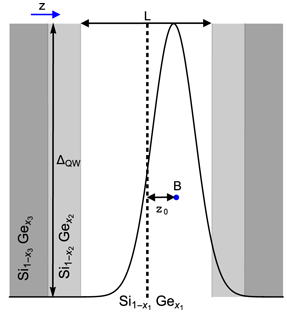 Spin qubit manipulation of acceptor bound states in group IV quantum wellsJ C Abadillo-Uriel, and M J CalderónNew Journal of Physics, Apr 2017
Spin qubit manipulation of acceptor bound states in group IV quantum wellsJ C Abadillo-Uriel, and M J CalderónNew Journal of Physics, Apr 2017The large spin–orbit coupling in the valence band of group IV semiconductors provides an electric field knob for spin-qubit manipulation. This fact can be exploited with acceptor based qubits. Spin manipulation of holes bound to acceptors in engineered SiGe quantum wells depends very strongly on the electric field applied and on the heterostructure parameters. The g-factor is enhanced by the Ge content and can be tuned by shifting the hole wave-function between the heterostructure constituent layers. The lack of inversion symmetry induced both by the quantum well and the electric fields together with the g-factor tunability allows the possibility of different qubit manipulation methods such as electron spin resonance, electric dipole spin resonance and g-tensor modulation resonance. Rabi frequencies up to hundreds of MHz can be achieved by electric field manipulation of heavy-hole qubits, and of the order of GHz with light-hole qubits.
@article{abadillo2017spin, doi = {10.1088/1367-2630/aa695f}, url = {https://dx.doi.org/10.1088/1367-2630/aa695f}, year = {2017}, month = apr, publisher = {IOP Publishing}, volume = {19}, number = {4}, pages = {043027}, author = {Abadillo-Uriel, J C and Calderón, M J}, title = {Spin qubit manipulation of acceptor bound states in group IV quantum wells}, journal = {New Journal of Physics}, }
2015
-
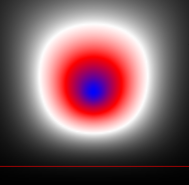 Interface effects on acceptor qubits in silicon and germaniumJ C Abadillo-Uriel, and M J CalderónNanotechnology, Nov 2015
Interface effects on acceptor qubits in silicon and germaniumJ C Abadillo-Uriel, and M J CalderónNanotechnology, Nov 2015Dopant-based quantum computing implementations often require the dopants to be situated close to an interface to facilitate qubit manipulation with local gates. Interfaces not only modify the energies of the bound states but also affect their symmetry. Making use of the successful effective mass theory we study the energy spectra of acceptors in Si or Ge taking into account the quantum confinement, the dielectric mismatch and the central cell effects. The presence of an interface puts constraints to the allowed symmetries and leads to the splitting of the ground state in two Kramers doublets (Mol et al 2015 Appl. Phys. Lett. 106 203110). Inversion symmetry breaking also implies parity mixing which affects the allowed optical transitions. Consequences for acceptor qubits are discussed.
@article{Abadillo-Uriel_2016, doi = {10.1088/0957-4484/27/2/024003}, url = {https://dx.doi.org/10.1088/0957-4484/27/2/024003}, year = {2015}, month = nov, publisher = {IOP Publishing}, volume = {27}, number = {2}, pages = {024003}, author = {Abadillo-Uriel, J C and Calderón, M J}, title = {Interface effects on acceptor qubits in silicon and germanium}, journal = {Nanotechnology}, }